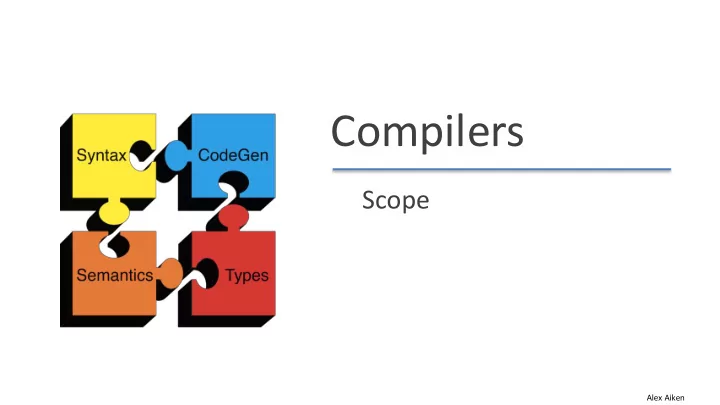

Compilers Scope Alex Aiken
Scope • Matching identifier declarations with uses – Important static analysis step in most languages – Including COOL! Alex Aiken
Scope • Example 1 let y: String “ abc ” in y + 3 • Example 2 let y: Int in x + 3 Alex Aiken
Scope • The scope of an identifier is the portion of a program in which that identifier is accessible • The same identifier may refer to different things in different parts of the program – Different scopes for same name don’t overlap • An identifier may have restricted scope Alex Aiken
Scope • Most languages have static scope – Scope depends only on the program text, not run-time behavior – Cool has static scope • A few languages are dynamically scoped – Lisp, SNOBOL – Lisp has changed to mostly static scoping – Scope depends on execution of the program Alex Aiken
Scope let x: Int <- 0 in { x; let x: Int <- 1 in x; x; } Alex Aiken
Scope • A dynamically-scoped variable refers to the closest enclosing binding in the execution of the program • Example g(y) = let a 4 in f(3); f(x) = a; • More about dynamic scope later . . . Alex Aiken
Scope • Cool identifier bindings are introduced by – Class declarations (introduce class names) – Method definitions (introduce method names) – Let expressions (introduce object id’s) – Formal parameters (introduce object id’s) – Attribute definitions (introduce object id’s) – Case expressions (introduce object id’s) Alex Aiken
Scope • Not all identifiers follow the most-closely nested rule • For example, class definitions in Cool – Cannot be nested – Are globally visible throughout the program • A class name can be used before it is defined Alex Aiken
Scope Class Foo { . . . let y: Bar in . . . }; Class Bar { . . . }; Alex Aiken
Scope Attribute names are global within the class in which they are defined Class Foo { f(): Int { a }; a: Int 0; } Alex Aiken
Scope • Method names have complex rules • A method need not be defined in the class in which it is used, but in some parent class • Methods may also be redefined (overridden) Alex Aiken
Scope Choose whether or not each variable use binds to the name on the given line 1 Class Foo { 2 f(x: Int): Int { 3 { 4 let x: Int <- 4 in { Line 6 binds to line 2 6 x; 7 let x: Int <- 7 in 8 x; Line 9 binds to line 7 9 x; 10 }; Line 11 binds to line 2 11 x; 12 }; 13 }; Line 11 binds to line 14 14 x: Int <- 14; 15 }
Recommend
More recommend